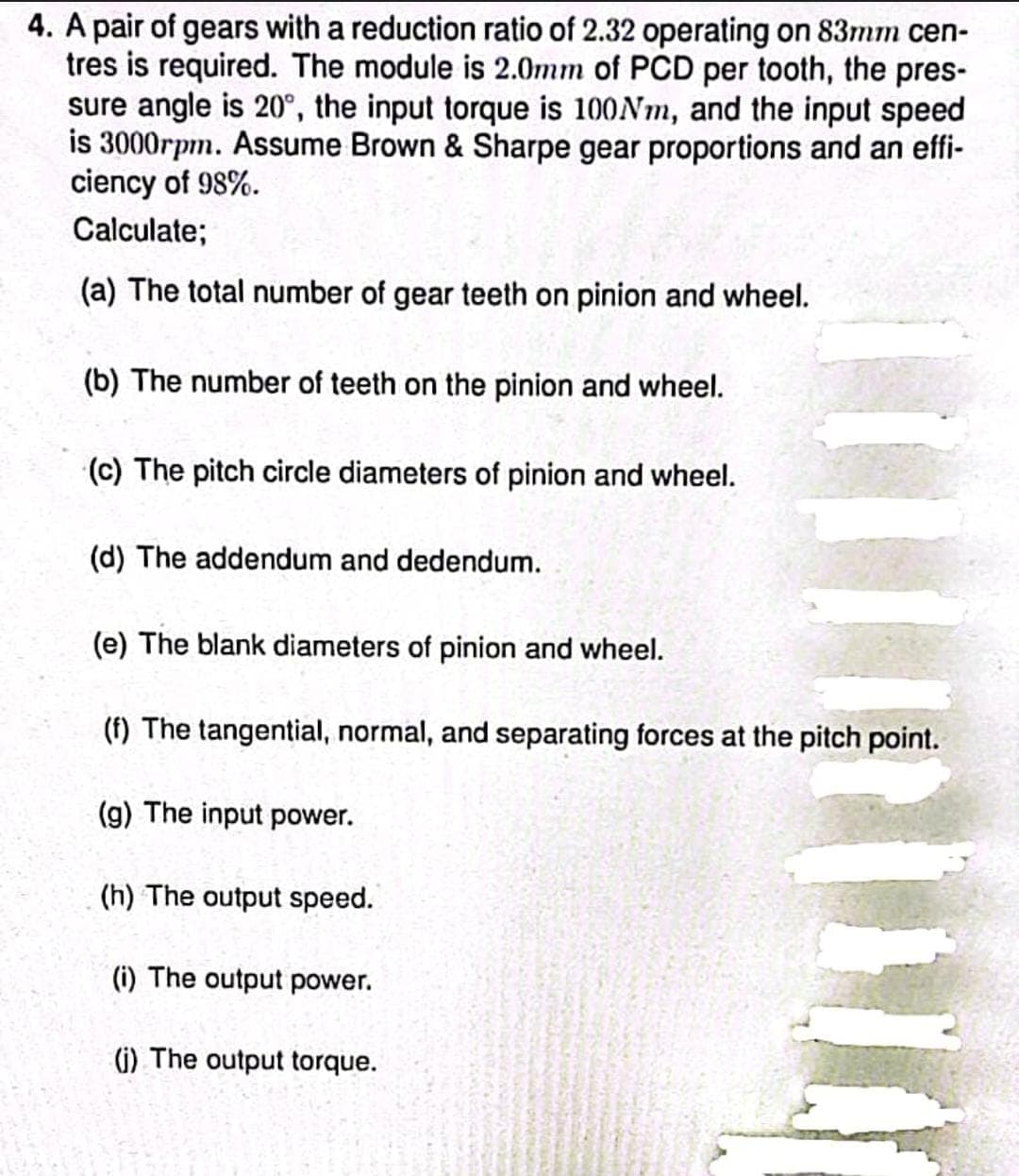4. A pair of gears with a reduction ratio of 2.32 operating on 83mm cen- tres is required. The module is 2.0mm of PCD per tooth, the pres- sure angle is 20°, the input torque is 100Nm, and the input speed is 3000rpm. Assume Brown & Sharpe gear proportions and an effi- ciency of 98%. Calculate; (a) The total number of gear teeth on pinion and wheel. (b) The number of teeth on the pinion and wheel. (c) The pitch circle diameters of pinion and wheel. (d) The addendum and dedendum. (e) The blank diameters of pinion and wheel. (f) The tangential, normal, and separating forces at the pitch point. (g) The input power. (h) The output speed. (i) The output power. (i) The output torque. 11 20
4. A pair of gears with a reduction ratio of 2.32 operating on 83mm cen- tres is required. The module is 2.0mm of PCD per tooth, the pres- sure angle is 20°, the input torque is 100Nm, and the input speed is 3000rpm. Assume Brown & Sharpe gear proportions and an effi- ciency of 98%. Calculate; (a) The total number of gear teeth on pinion and wheel. (b) The number of teeth on the pinion and wheel. (c) The pitch circle diameters of pinion and wheel. (d) The addendum and dedendum. (e) The blank diameters of pinion and wheel. (f) The tangential, normal, and separating forces at the pitch point. (g) The input power. (h) The output speed. (i) The output power. (i) The output torque. 11 20
Elements Of Electromagnetics
7th Edition
ISBN:9780190698614
Author:Sadiku, Matthew N. O.
Publisher:Sadiku, Matthew N. O.
ChapterMA: Math Assessment
Section: Chapter Questions
Problem 1.1MA
Related questions
Question
Please send complete H part only
output speed , power , torque

Transcribed Image Text:4. A pair of gears with a reduction ratio of 2.32 operating on 83mm cen-
tres is required. The module is 2.0mm of PCD per tooth, the pres-
sure angle is 20°, the input torque is 100Nm, and the input speed
is 3000rpm. Assume Brown & Sharpe gear proportions and an effi-
ciency of 98%.
Calculate;
(a) The total number of gear teeth on pinion and wheel.
(b) The number of teeth on the pinion and wheel.
(c) The pitch circle diameters of pinion and wheel.
(d) The addendum and dedendum.
(e) The blank diameters of pinion and wheel.
(f) The tangential, normal, and separating forces at the pitch point.
(g) The input power.
(h) The output speed.
(i) The output power.
(i) The output torque.
11
20
Expert Solution
This question has been solved!
Explore an expertly crafted, step-by-step solution for a thorough understanding of key concepts.
Step by step
Solved in 2 steps with 1 images

Knowledge Booster
Learn more about
Need a deep-dive on the concept behind this application? Look no further. Learn more about this topic, mechanical-engineering and related others by exploring similar questions and additional content below.Recommended textbooks for you

Elements Of Electromagnetics
Mechanical Engineering
ISBN:
9780190698614
Author:
Sadiku, Matthew N. O.
Publisher:
Oxford University Press

Mechanics of Materials (10th Edition)
Mechanical Engineering
ISBN:
9780134319650
Author:
Russell C. Hibbeler
Publisher:
PEARSON

Thermodynamics: An Engineering Approach
Mechanical Engineering
ISBN:
9781259822674
Author:
Yunus A. Cengel Dr., Michael A. Boles
Publisher:
McGraw-Hill Education

Elements Of Electromagnetics
Mechanical Engineering
ISBN:
9780190698614
Author:
Sadiku, Matthew N. O.
Publisher:
Oxford University Press

Mechanics of Materials (10th Edition)
Mechanical Engineering
ISBN:
9780134319650
Author:
Russell C. Hibbeler
Publisher:
PEARSON

Thermodynamics: An Engineering Approach
Mechanical Engineering
ISBN:
9781259822674
Author:
Yunus A. Cengel Dr., Michael A. Boles
Publisher:
McGraw-Hill Education

Control Systems Engineering
Mechanical Engineering
ISBN:
9781118170519
Author:
Norman S. Nise
Publisher:
WILEY

Mechanics of Materials (MindTap Course List)
Mechanical Engineering
ISBN:
9781337093347
Author:
Barry J. Goodno, James M. Gere
Publisher:
Cengage Learning

Engineering Mechanics: Statics
Mechanical Engineering
ISBN:
9781118807330
Author:
James L. Meriam, L. G. Kraige, J. N. Bolton
Publisher:
WILEY